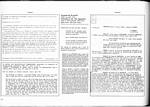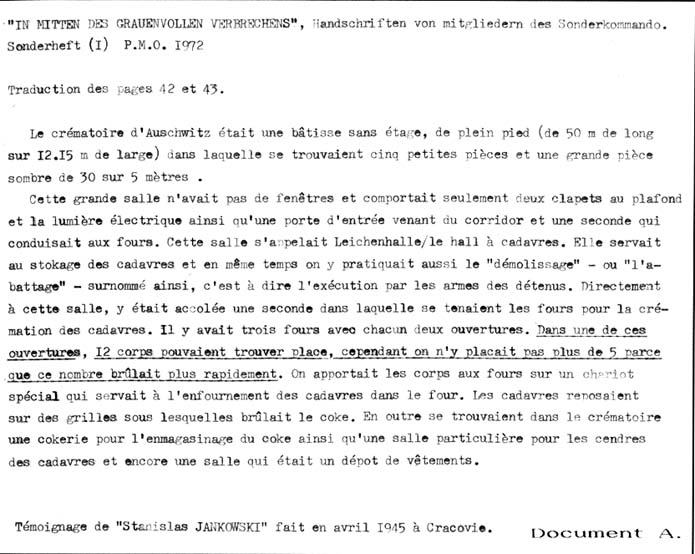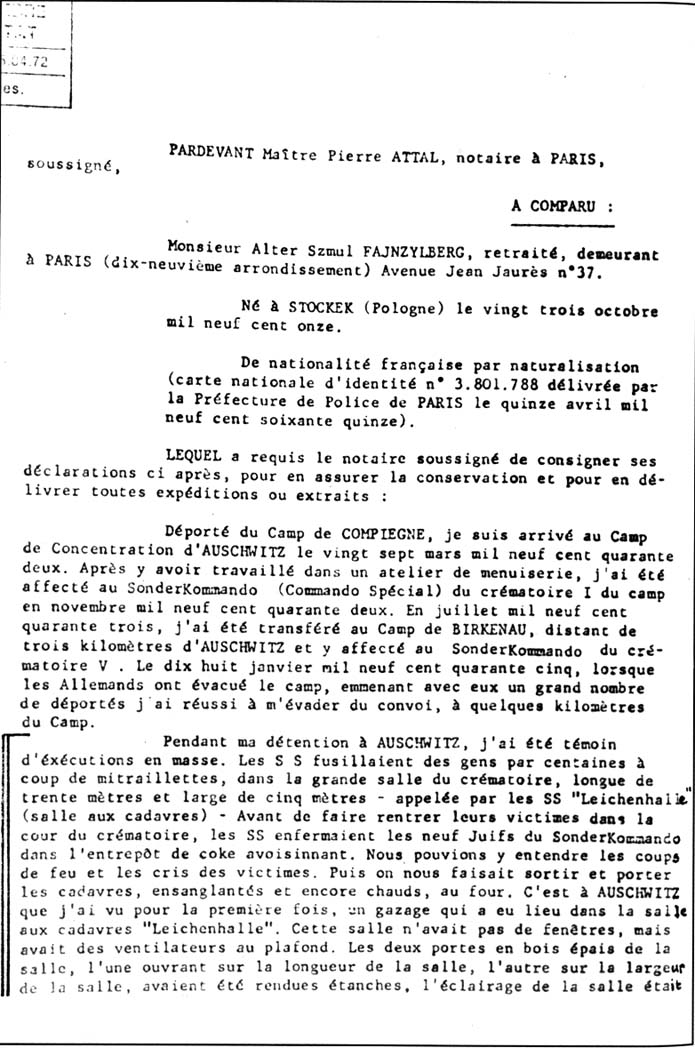|
|
 |
 |
AUSCHWITZ:
Technique
and Operation
of
the Gas Chambers © |
|
|
| |
 |
Back |
 |
Contents |
Page 124 |
 |
Home
Page |
Forward |
 |
| |
| Document
A |
 |
| |
“IN MITTEN DES GRAUENVOLLEN
VERBRECHENS: Handschriften von Milgliedern des Sonderkommando Sonderheft (I)
PMO” 1972, pages 42 and 43.
[“AMIDST A NIGHTMARE OF
CRIME, Notes of prisoners of Sonderkommando found at Auschwitz,
P.M.O.”, Special issue, 1973, Pages 40, 41 and 42]
From
the testimony of “Stanislas Jankowski”, Cracow, April
1945. |
| |
The crematorium at Auschwitz — a one storied
building (some 50 meters long, 12 15 meters wide), in which there were five
smaller rooms and one big hall, dark, 30 by 5 meters.
This big hall had
no windows, only two vents in the ceiling, electric light and one door leading
from the corridor, the other door leading to the ovens. This hall was called
Leichenhalle (hall of corpses). It served as mortuary and at the same time for
so called “shambles” [“demolition” or
“slaughtering”], that is, for shooting prisoners. Directly adjoining
was another hall where the cremating ovens for burning corpses were. There were
three ovens and each had two openings, 12 corpses could be put into one
opening, but no more than 5 were usually put, as they burnt more quickly in
that quantity. The corpses were put into the ovens in so called special
carts which, after dumping the corpses, were removed from the ovens, The
corpses lay on grates under which coke was burning. The crematorium, moreover,
possessed a coke store where coke was kept, then a special room for the ashes
from the corpses and still another room which was a clothes
store. |
| |
| |
Document B1
Documents B1, B2 and B3:
[PMO microfilm 1254]
Declaration by Mr. Alter Fajnzylberg
made on 29th
September 1980 before
Maitre Pierre Attal, Paris Notary |
|
| |
| Document B1 |
 |
| |
| BEFORE Maitre Pierre Attal, Paris Notary,
undersigned |
| |
APPEARED Mr Alter Fajnzylberg, retired,
domiciled in Paris (nineteenth arrondissement),
Avenue Jean
Jaurès, No 27.
Born in STOCKEK (Poland), 23rd October 1911.
Of French nationality by naturalisation (Identity
Card No 3 801
788, issued by the Préfecture
de Police de Paris on 15th April
1975 |
| WHO requested the undersigned notary to record
the following declaration in order to ensure its conservation and to
communicate it in whole or in part: |
| |
“Deported from the COMPIEGNE camp, I arrived
at the Auschwitz concentration camp on 27th March 1942. After having worked in
the carpenters’ shop there, I was transferred to the Sonderkommando
(special kommando) of Krematorium I of the camp in November 1942. In July 1943,
I was transferred to the Birkenau camp, three kilometers from Auschwitz and
detailed to the Krematorium V Sonderkommando. On 18th January 1945, when the
Germans evacuated the camp, taking with them a great number of deportees, I
managed to escape from the convoy a few kilometers from the camp.
“During my detention in Auschwitz, I witnessed mass executions.
The SS shot people in the hundreds using machine guns on the big room of the
Krematorium, 30 meters long and 5 meters wide, called by the SS the
“Leichenhalle/ corpse hall”. Before bringing their victims into the
yard of Krematorium, the SS shut the nine Jews of the Sonderkommando in the
adjoining coke store. There we could hear the shots and the cries of the
victims. Then they brought us out and made us carry the bodies, covered in
blood and still warm, to the furnaces. It is at Auschwitz that I saw for the
first time a gassing in the Leichenhalle. This room had no windows, but there
were ventilators in the ceiling. The two thick wooden doors of the room, one in
the side wall, the other in the end wall, had been made gas tight. The room was
lit by electricity. The victims of the gassing were about 400 Jews brought from
Birkenau. The men of the Sonderkommando, including myself, saw them enter the
yard then we were shut in the coke store. When the Sonderkommando men came out,
they saw and I saw, only their clothes in the yard.” |
|
| |
AUSCHWITZ:
Technique and operation
of the gas
chambers
Jean-Claude Pressac
© 1989, The Beate Klarsfeld Foundation |
 |
Back |
Page 124 |
Forward |
 |
|

